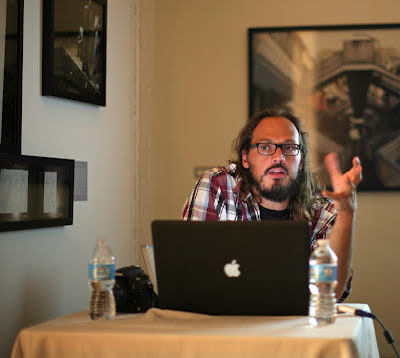Curated by Andy Adams and produced in conjunction with the exhibition America in View: Landscape Photography 1865 to Now, organized by the Museum of Art, Rhode Island School of Design, Providence, Rhode Island, and shown there September 21, 2012 - January 13, 2013. This exhibit is presented as a video slideshow as well as individually accessible images containing detailed information about the photographers and a short interview format.
 |
| Emily Shur Parking Lot Sedona, Arizona (2010) |
"Photographers are doing what they’ve always done — looking at the land with a camera to explore, understand, critique and comment upon humankind’s relationship with nature. The subject matter has changed with each new generation, as have the impressions of the photographers behind the lens. This survey is by no means exhaustive but it does signal the beginning of a fertile new era in the ever-evolving landscape photo tradition. It studies a cross-section of current landscape photography in the documentary style. Most of these pictures depict actual places and their content says much about the United States and the American people. We live in a post-New Topographics landscape where an entire generation of photographers was born and raised in suburban sprawl. Wilderness is a foreign concept. Our environment has been significantly altered. We live with nature at arm's length. Photography describes these things."-Andy Adams, Looking at the Land
 |
| Christine Carr 221.05.1.250 Roanoke, Virginia (2005) |
When we really begin to think about the landscape, and look beyond the cliche and romantic images that might appear in our heads when hearing the words Landscape Photography, it quickly becomes apparent just how ambiguous the concept really is. The landscape is both a visual experience and a cognitive puzzle without an obvious solution. The American landscape has intrigued artists and geographers for centuries, the best of which have never stopped asking themselves why things look the way they do.
In The Interpretation of Ordinary Landscapes (1979 Oxford Press) , D. W. Meinig's essay The Beholding Eye offers what I have found to be one of the most helpful ways in which to categorize and evaluate landscapes. Meinig breaks down the landscape into a pattern of language based on ten elements; landscape as Nature, landscape as Habitat, landscape as Artifact, landscape as System, landscape as Problem, landscape as Wealth, landscape as Ideology, landscape as History, landscape as Place, and landscape as Aesthetic. This language of landscape allows us to analyse and better appreciate not only the visual aspects of the landscape, but also the cultural and psychological qualities. And while this is obviously most helpful for academics like Meinig and J B Jackson (etal), I think it is just as useful to curators and photographers/artists in search of deeper understanding of the ambiguous meanings within the contemporary landscape. Based on Meinig's elements as a benchmark, I think Andy Adams did a remarkable job with his selections. Eighty eight images were chosen from a submission pool of over five thousand. As a back story to the photographs in the exhibit, each photographer was asked the same set of four questions, including one about the specifics of place and another that explores the compulsion of the artist to photograph the land. The answers are as intriguing and insightful as the images.
 |
| Mike Sinclair Western Auto Building from 22nd & Main Street Kansas City (2010) |
I'm not sure I agree with Andy Adams about today being a post-New Topographic landscape. For better or worse, the landscape hasn't changed all that much since the mid-nineteen seventies and neither has the general aesthetic of contemporary landscape photography. The influence of the New Topographic photographers and the New Color photographers of the 1970's is very evident among the images being presented. Stephen Shore, Robert Adams, Len Jenshel, Joel Meyerowitz, and a few others are eerily present and hovering over this exhibition. I'm not saying that is a bad thing. I love those photographers. We're not quite ready to declare independence and graduation from the influences of such recent photographic past is the only point I am trying to make.
 |
| Ian Baguskas Two Structures Death Valley, California (2008) |
This is, however, a post- Gallery Centric exhibition. The evolution of the online exhibition format has been relatively slow and hindered when compared to the frenetic pace of internet time, but Adams has his foot on the accelerator. I won't get into the details of the development of this exhibition. There is an excellent piece written by Paul Moakley on Time Lightbox that needs to be read to fully appreciate the significance and success of what Andy Adams has accomplished not only with this exhibit, but also in shaping the virtual contemporary photography landscape. We are witnessing a new interpretation of the exhibition format.













